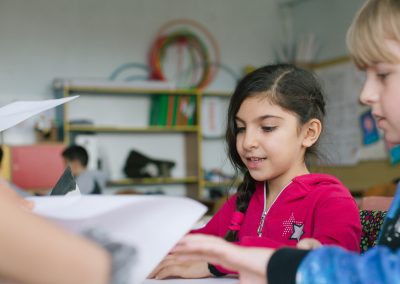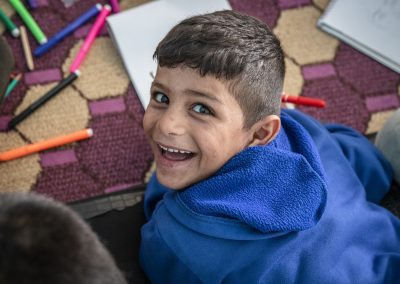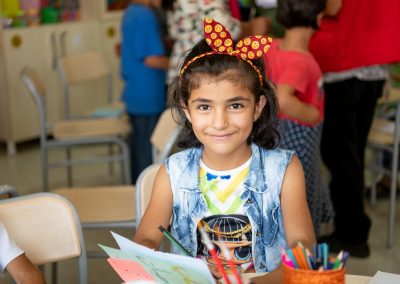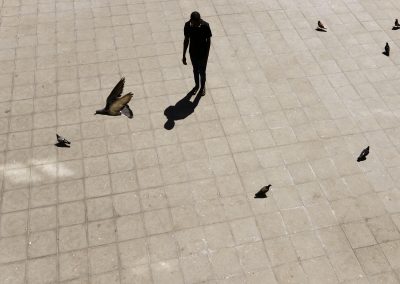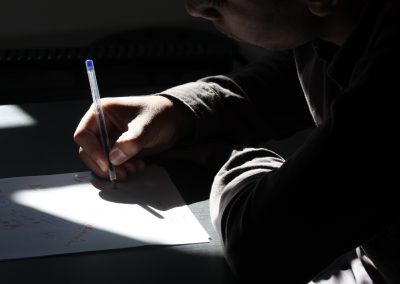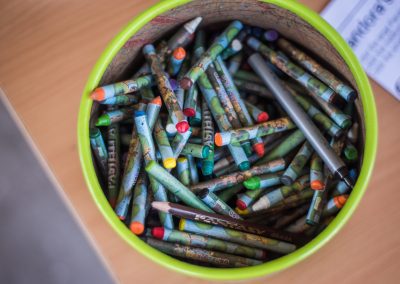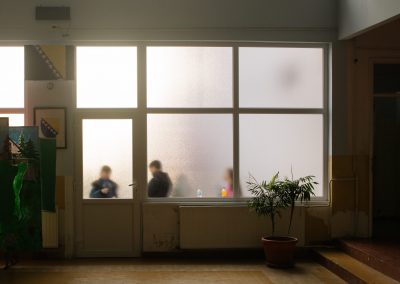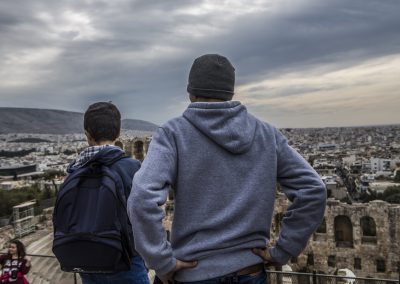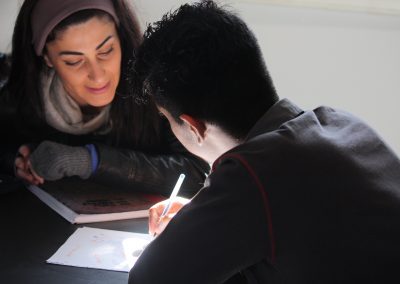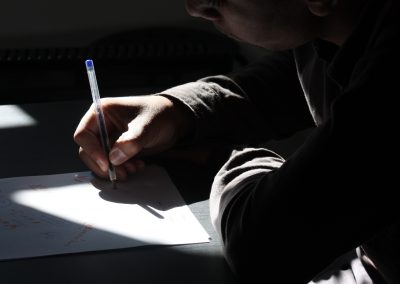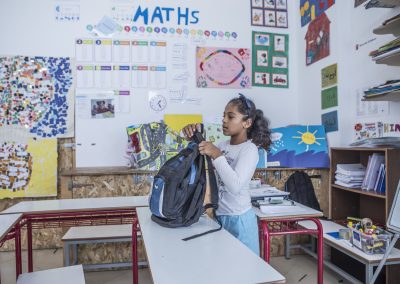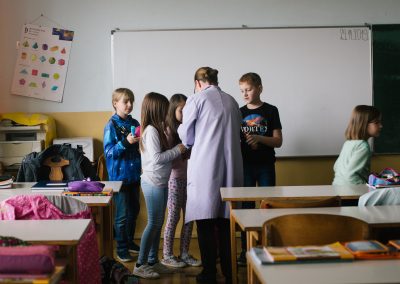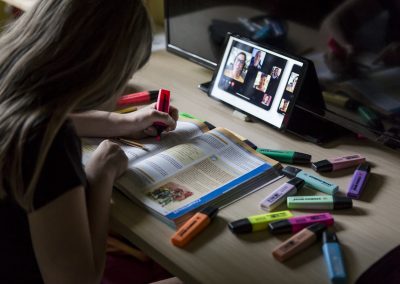Images of individuals are the copyright of Save the Children or the personal property of the person displayed.
You may not use, distribute, modify, transmit, or post the content of the REFUGE-ED website, including any text, images, audio, or video, without the written permission of REFUGE-ED.
Save the Children activities in Bosnia
Furugh, 9 years old, from Iran, in Bihac, Bosnia. Save the Children facilitates school enrolment for refugee and migrant children by providing school escorts, cultural mediators, school meals and other support to local schools.
Save the Children activities in Iraq
Children take part in creative activities during a HEART session held at a Save the Children education centre in a camp for Syrian refugees in northern Iraq. Through painting, music, drama, and many other art forms, Save the Children’s HEART (Healing and Education Through the Arts) program helps children affected by serious or chronic stress find new ways to share their feelings and experiences. Research shows that artistic expression has a powerful effect on a child’s social and emotional wellbeing, as well as educational value, especially for children in stressful situations. When a child shares his or her memories and feelings through artistic expression, they can begin to feel less isolated and more connected and safe amidst the trusted adults and peers in their lives. HEART supports children and youth age 3-18 and also support adults including parents, teachers and community centre facilitators.
Alasan* (16) from The Gambia
Alasan* (16) from The Gambia, is in Italy unaccompanied. He says: “I’m from a small village in the Central River Region. I still know the exact date I left the house: it was on the 5th of February 2015. I’ve been on the road for well over a year. Both my parents died a long time ago, so I stayed with my uncle. He wanted me to go to a religious school and study religion two days a week, but I didn’t want to do it. I wanted to study the western way, in school where you get all kinds of subjects. My uncle wanted me to go to the religious school at least two days a week, but I decided that would take too much time and that I wouldn’t have enough time for my other classes. After I stood up to my uncle, he stopped paying for my normal lessons and wanted me to study religion full time. He was angry with me and threatened to beat me many times. I found a way to make some money, left home and went on my trip. I went to Senegal, Mali, Burkina and Niger, and then I went into Libya. When I got there, I was out of money so I had to work. I was in Sabha, one of the most dangerous towns of the country. First I worked for a nice man and I was able to save some money. But at one point, the man didn’t have work for me any more and I had to go looking for work. You go out in the streets and hope somebody picks you up for a day’s work. Many Africans do it. But the police came and took us straight to prison, because we were illegal. I was in prison for almost 6 months, and we got beaten almost every day. When you go out of the cell to eat, they beat you. And they kept beating. A brother of my best friend died there, he was sick but they refused to take him to a hospital. At a certain point they let us go and we left the town. Our driver wanted to bring us to Tripoli, but he said that because my friend was sick, they’d refuse to let us into town. He decided to take us straight to Sabratha, a smugglers town. We stayed there on the beach for two months, we wo
Sixteen-year-old Umair* is from Pakistan
Sixteen-year-old Umair* is from Pakistan and travelled to Greece on his own. He was held in Moria detention centre for months on the Greek island of Lesvos where he says he felt like he was living in jail. Umair now lives in a shelter for unaccompanied children in Lesvos. The shelter is run by Save the Children’s partner Praksis and provides accommodation; food; health services; classes in maths, various languages including English and Greek; psychosocial counselling; cultural and recreational activities; communication support to maintain family links; and legal information and assistance. With support from the lawyer at the shelter, Umair has applied for asylum in Greece. The shelter is funded by Save the Children and the United Kingdom’s Department for International Development.
Save the Children activities in Bosnia
Around 2000 children in Bosnia are forced to beg on the streets every day; many of them are Roma or belong to other minorities. Only a generation away from violent war and still heavily burdened with political tensions and economic hardships, governmental institutions often fail to provide sufficient support for particularly vulnerable children and their families. Save the Children supports the work of five drop-in centres in the North-West Balkans. Together, these five centres have close to 800 regular beneficiaries, along with as much as 2000 children that occasionally use some of the services. Many Bosnian families lack the financial resources to send their children to school or even ensure basic means of living. In the drop-in centre the children are supported to enroll in school, provided with school materials and warm meals, learn how to read and write, receive support in doing their homework and, most importantly, they can use their leisure time to play with other children. German Bulgari brand ambassador Princess Lilly zu Sayn Wittgenstein-Berleburg visited one of the drop-in centres in Brčko on July, 20th 2017.
School in the Bihac region
In this school in the Bihac region of Bosnia where children on the move, Roma and Bosnian children learn together. Save the Children facilitates school enrolment for refugee and migrant children by providing school escorts, cultural mediators, school meals and other support to local schools. *see separate case study with Headteacher Hajrudin.
unaccompanied children
A group of unaccompanied children visit the Acropolis of Athens, accompanied by a Save the Children care-giver and a cultural mediator. The children, mainly from Afghanistan, Syria and Pakistan, are staying in Athens in a shelter run by Save the Children and funded by the European Commission’s Humanitarian Aid department (ECHO). . .The shelter provides children with accommodation; 24-hour support; food; health services; classes in maths, various languages including English and Greek; psychosocial counselling; cultural and recreational activities; communication support to maintain family links; and legal information and assistance. . .The trip to see the Acropolis is one of many activities and excursions planned for the children during their stay in Greece, and while they wait for the paperwork that would allow them to legally move on or claim asylum in Greece.
Save the Children activities in Greece
Sixteen-year-old Umair* is from Pakistan and travelled to Greece on his own. He was held in Moria detention centre for months on the Greek island of Lesvos where he says he felt like he was living in jail. Umair now lives in a shelter for unaccompanied children in Lesvos. The shelter is run by Save the Children’s partner Praksis and provides accommodation; food; health services; classes in maths, various languages including English and Greek; psychosocial counselling; cultural and recreational activities; communication support to maintain family links; and legal information and assistance. With support from the lawyer at the shelter, Umair has applied for asylum in Greece. The shelter is funded by Save the Children and the United Kingdom’s Department for International Development.
Save the Children activities in Greece
Sixteen-year-old Umair* is from Pakistan and travelled to Greece on his own. He was held in Moria detention centre for months on the Greek island of Lesvos where he says he felt like he was living in jail. Umair now lives in a shelter for unaccompanied children in Lesvos. The shelter is run by Save the Children’s partner Praksis and provides accommodation; food; health services; classes in maths, various languages including English and Greek; psychosocial counselling; cultural and recreational activities; communication support to maintain family links; and legal information and assistance. With support from the lawyer at the shelter, Umair has applied for asylum in Greece. The shelter is funded by Save the Children and the United Kingdom’s Department for International Development.
Save the Children activities in Greece
Our teachers in Northern Greece support children between 6 to 15 years old who attend the Greek school, by assisting them with their homework and strengthening their knowledge of Greek, English and Math. They also offer basic and intermediate Greek and English language classes to young people from 16 to 24 years old.Project information and major issues: Since the beginning of 2015, Greece has been the entry point into Europe for more than 1 million refugees and migrants seeking safety and security for them and their families. When the borders were open, people arriving on the islands would travel to the mainland and the northern border, then transit through the Former Yugoslav Republic of Macedonia (FYROM), Serbia, æCroatia and Slovenia, to Austria and Germany. æWith the border between Greece and FYROM officially closed, more than 62, 300 people are stranded in Greece, including more than 14, 000 people held on the islands as part of the EU agreement with Turkey.
Save the Children activities in Bosnia
Refugee children who live in nearby camps are supported by Save the Children to attend school, including with the help of cultural mediators who speak their language, like Tina.

